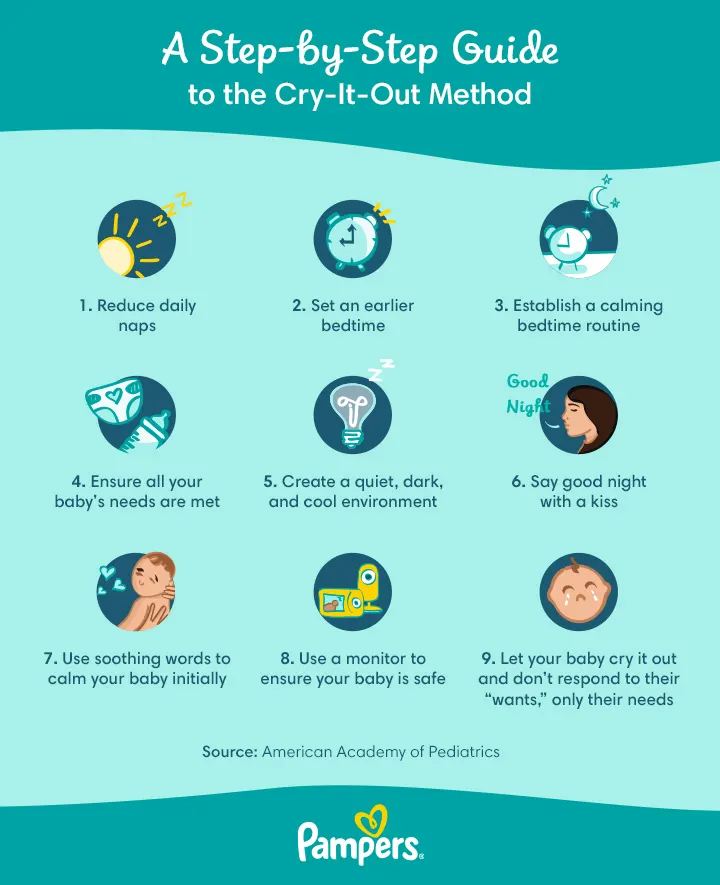How long should you let a toddler cry it out? The answer isn’t a simple one. There is no one-size-fits-all duration, and it greatly depends on the age of the child, the specific sleep training method being used, and the parents’ comfort level. While some experts suggest implementing the cry it out method duration with checks after a few minutes, others advocate for a more gradual approach. This article will explore various aspects of the cry it out (CIO) method, including factors influencing acceptable crying time for toddlers, how to determine when how long is too long for cry it out, and ensure crying it out safety. We will also consider alternative methods and the effects of prolonged crying in toddlers.

Image Source: images.ctfassets.net
Decoding the Cry It Out Method
The Cry It Out (CIO) method, at its core, involves allowing a child to self-soothe and fall asleep independently, even if it means crying for a period of time. There are different variations of this approach, and it’s vital to choose one that aligns with your parenting philosophy and your child’s temperament.
Different Approaches to Cry It Out
-
Extinction Method (Unmodified CIO): This involves putting the child to bed and not returning until the morning. This is often the most controversial and intense method.
-
Gradual Extinction (Controlled Crying): This involves checking on the child at increasingly longer intervals while still allowing them to cry for a specified period. This approach is also referred to as controlled crying for toddlers.
-
Fading Method: This involves gradually reducing parental involvement at bedtime, allowing the child more and more independence until they can fall asleep on their own.
Age Appropriate Cry It Out: When is it Safe to Start?
Typically, experts recommend waiting until a baby is at least 6 months old before considering any form of CIO. Before this age, babies need frequent feedings and comforting. Starting around 6 months allows you to implement age appropriate cry it out methods, coinciding with toddler crying milestones. However, every child is different, and you should always consult with your pediatrician before starting any sleep training method.
Key Factors Influencing Cry It Out Method Duration
Several factors influence the appropriate cry it out method duration, and it is important to assess these elements before embarking on sleep training.
Child’s Age & Development
A younger toddler (12-18 months) might require a gentler approach with frequent checks compared to an older toddler (2-3 years) who might respond better to a more consistent routine.
Temperament
Some toddlers are naturally more adaptable and resilient, while others are more sensitive and prone to prolonged crying. A sensitive child might benefit from a gradual extinction approach.
Overall Health
Ensure your toddler is healthy and not experiencing any underlying medical conditions (like ear infections or reflux) that could be causing discomfort and leading to crying.
Consistency
Whatever method you choose, consistency is key. Inconsistency can confuse the child and prolong the process.
Parental Comfort Level
The acceptable crying time for toddlers also depends on the parents’ comfort level. Some parents are more comfortable with longer periods of crying than others. It’s essential to choose a method that you can consistently follow.
Acceptable Crying Time for Toddlers: Setting Realistic Expectations
Determining the acceptable crying time for toddlers is a crucial step in implementing the CIO method effectively.
What is Considered “Too Much” Crying?
While there’s no universally agreed-upon limit, most experts suggest that crying lasting longer than one hour consistently each night might indicate that the method isn’t working or that there’s an underlying issue. Furthermore, prolonged, inconsolable crying can cause undue stress for both the child and the parents. If how long is too long for cry it out is on your mind, it’s always best to err on the side of caution.
Signs the CIO Method Isn’t Working
- Crying escalates or becomes hysterical.
- The child becomes overly distressed or shows signs of physical distress.
- The child’s crying doesn’t decrease after several nights.
- The child develops new anxiety or behavioral issues.
When to Reassess and Seek Help
If you observe any of the above signs, it’s essential to reassess the method and potentially seek guidance from a sleep consultant or pediatrician.
Creating a Safe Environment for Cry It Out
Crying it out safety is paramount. Ensure the following precautions are in place before starting:
Bedding and Sleep Environment
- Use a firm mattress.
- Avoid loose bedding, pillows, or stuffed animals in the crib.
- Keep the room at a comfortable temperature.
- Ensure the crib meets current safety standards.
Monitoring the Child
- Consider using a video monitor to observe the child’s behavior and ensure their safety.
- Check on the child periodically (especially with gradual extinction methods) to ensure they are not in distress.
Addressing Physical Needs
- Ensure the child is not crying due to hunger, thirst, or a soiled diaper.
- Establish a consistent bedtime routine to signal sleep.
Decoding the Toddler Sleep Training Timeline
The toddler sleep training timeline varies significantly depending on the chosen method and the individual child. Here’s a general overview:
Initial Days (1-3)
Expect the most crying during these initial days. With the extinction method, crying might last for an hour or more. With gradual extinction, the crying might be shorter but still significant.
Stabilization Phase (4-7)
Crying should gradually decrease during this phase. The child starts to learn self-soothing techniques and fall asleep more easily.
Maintenance Phase (After 7 Days)
The child should consistently fall asleep within a reasonable timeframe with minimal crying. However, occasional crying might still occur during toddler sleep regression cry it out situations.
Table: Expected Crying Duration (General Guidelines)
| Method | Day 1 | Day 3 | Day 7 |
|---|---|---|---|
| Extinction | 45-60+ minutes | 30-45 minutes | 15-30 minutes |
| Gradual Extinction | 30-45 minutes | 15-30 minutes | 5-15 minutes |
Note: These are general guidelines, and individual results may vary.
The Effects of Prolonged Crying in Toddlers: Separating Fact from Fiction
It’s natural to worry about the effects of prolonged crying in toddlers. While some concerns have been raised, research suggests that the CIO method, when implemented appropriately, does not cause long-term harm.
Research Findings
- Studies have shown that the CIO method does not negatively impact attachment.
- There’s no evidence that it causes long-term psychological damage.
Potential Risks
- Prolonged, inconsolable crying can lead to increased stress hormones (cortisol) in the short term.
- If the child is crying due to an unmet need (hunger, pain, etc.), ignoring the crying can be detrimental.
Mitigating Risks
- Ensure all the child’s needs are met before bedtime.
- Choose a sleep training method that aligns with your parenting philosophy and the child’s temperament.
- Monitor the child closely and reassess if needed.
Addressing Toddler Sleep Regression Cry It Out
Toddler sleep regression cry it out is often a challenging experience for both parents and children. Sleep regressions are periods when a child who was previously sleeping well suddenly starts waking up frequently or resisting bedtime.
Common Causes of Sleep Regression
- Developmental milestones (e.g., learning to walk or talk)
- Changes in routine (e.g., travel or a new sibling)
- Illness or teething
- Separation anxiety
Applying CIO During Sleep Regression
If you have previously used the CIO method successfully, you can often reapply it during a sleep regression. However, it’s crucial to rule out any underlying causes (e.g., illness) before resuming the method.
Tips for Navigating Sleep Regression
- Maintain a consistent bedtime routine.
- Offer extra comfort and reassurance during the day.
- Re-establish clear boundaries at bedtime.
- Be patient and understanding.
Alternatives to Cry It Out
If the CIO method doesn’t feel right for you or your child, several alternative sleep training approaches exist:
Gentle Sleep Training Methods
-
Chair Method: Sitting in a chair next to the crib and gradually moving it further away each night until you’re out of the room.
-
Pick-Up/Put-Down Method: Comforting the child when they cry and putting them back down as soon as they calm down.
-
Bedtime Fading: Adjusting bedtime to when the child is already sleepy.
Co-Sleeping and Bed-Sharing
- Some parents choose to co-sleep or bed-share with their children. While this can promote bonding, it’s essential to follow safe sleep guidelines to reduce the risk of SIDS.
Choosing the Right Method
The best sleep training method is the one that works best for your family. Consider your child’s temperament, your parenting style, and your comfort level when making your decision.
Seeking Professional Advice
When in doubt, seeking guidance from a sleep consultant or pediatrician can be invaluable. They can help you assess your child’s sleep patterns, identify any underlying issues, and develop a personalized sleep training plan.
Questions to Ask a Sleep Consultant
- What sleep training methods do you recommend?
- How long should I expect the process to take?
- What are the potential risks and benefits of each method?
- How can I handle setbacks or challenges?
Frequently Asked Questions (FAQ)
Q: What if my toddler throws up when crying?
A: If your toddler throws up while crying, it’s essential to clean them up, change their clothes, and comfort them. Consider pausing the CIO method for a few days and then reintroducing it more gradually. If vomiting persists, consult with your pediatrician.
Q: Can I use CIO if my toddler shares a room with a sibling?
A: Using CIO in a shared room can be challenging. It’s essential to consider the impact on the sibling. Using a white noise machine or room divider may help minimize disturbances. If possible, consider temporarily separating the children during sleep training.
Q: Is CIO cruel or harmful?
A: When implemented appropriately and with careful monitoring, research suggests that CIO is not harmful. However, prolonged, inconsolable crying or ignoring a child’s genuine needs can be detrimental. It’s crucial to choose a method that aligns with your parenting philosophy and the child’s temperament.
Q: My toddler suddenly started waking up at night again. What should I do?
A: This could be a sign of sleep regression. Review potential causes (e.g., developmental milestones, illness, changes in routine) and address any underlying issues. Re-establish a consistent bedtime routine and consider reapplying the CIO method or another sleep training approach.
Q: How do I know if CIO is right for my family?
A: Consider your child’s temperament, your parenting style, and your comfort level. If you are uncomfortable with letting your child cry, explore alternative sleep training methods. It’s also helpful to consult with your pediatrician or a sleep consultant for personalized guidance.

Clark Lubowitz is a parenting expert with over 10 years of experience in toddler care and child development. Holding a degree in Early Childhood Education, he specializes in blending modern technology with parenting, offering expert advice on the best toddler gadgets. Through his work on ToddlerAwesome.com, Clark provides valuable insights to help parents make informed decisions for their little ones.
